Blog
-
Shefqet Avdush Emini – Një Emër i Gravuar në Artin Ndërkombëtar
13 augustus 2025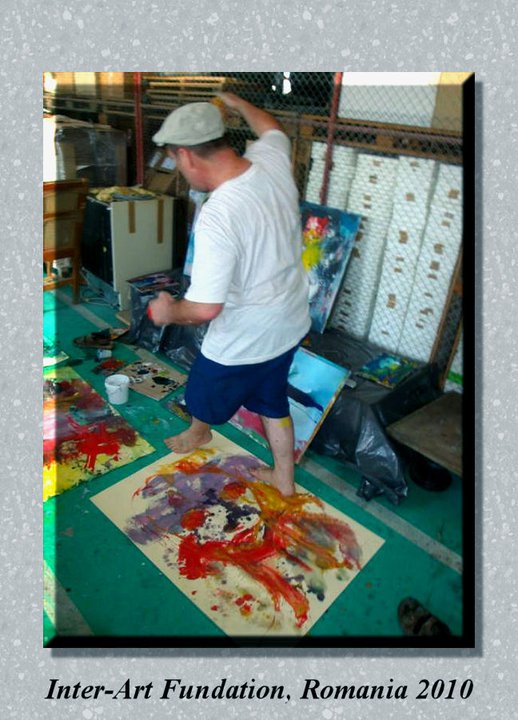
Shefqet Avdush Emini – Një Emër i Gravuar në Artin Ndërkombëtar
Shefqet Avdush Emini nuk është vetëm një artist. Ai është një forcë krijuese, një vizionar që sfidon kufijtë e mediumeve tradicionale dhe zbulon forma të reja të komunikimit estetik e filozofik përmes trupit të vet dhe shpirtit artistik. Në simpoziumin ndërkombëtar të organizuar nga Inter-Art Foundation në Rumani, viti 2010, Emini shfaqet jo vetëm si piktor, por si performues i artit në kuptimin më të pastër të fjalës: një njeri që e shndërron trupin në vegël krijimi dhe aktin në gjuhë të thellë emocionale.
Në këtë moment të veçantë, ku artisti pikturon me këmbë, përpara syve të publikut dhe kolegëve ndërkombëtarë, ai nuk e paraqet vetëm veprën si qëllim përfundimtar, por procesin si vepër më vete. Performanca e tij është një akt poetik, një ritual, një sfidë dhe një shpërthim i kontrolluar nga përvoja dhe ndjeshmëria.
1. Performanca si Ekspresion Total i Qenies
Aktualisht në epokën ku arti bashkëkohor shpesh kërkon spektaklin për të qenë i dukshëm, Shefqet Emini na kujton se nuk është spektakli ai që ka rëndësi, por përqendrimi i brendshëm dhe autenticiteti i gjestit. Performanca e tij është një akt i përqendruar shpirtërisht dhe fizikisht, ku çdo lëvizje, çdo shtypje e këmbës mbi telajo, është një formë lutjeje artistike.
Ai nuk e përdor trupin për të provokuar – ai e përdor atë për të shprehur diçka që nuk mund të thuhet me fjalë. Kjo është thelbësore për ta kuptuar seriozitetin e këtij akti performativ: nuk kemi të bëjmë me një eksperiment formalist, por me një mënyrë të thellë për të zhbërë distancën mes artistit dhe veprës së tij.
2. Shkathtësia e Artistit – Koordinim, Ndjenjë, Instinkt
Të pikturosh me këmbë kërkon më shumë se guxim: kërkon kontroll total të trupit dhe ndjeshmërisë. Artistët vizatimorë e dinë se kontrolli i dorës është vendimtar për rezultatet teknike – por në këtë rast, Emini shkon më tej: ai i dorëzon trupit detyrën për të shprehur emocionin.
Ai koordinon çdo lëvizje të këmbëve me ritmin e shpirtit të vet, ndërkohë që lëviz në një sipërfaqe të lagur me ngjyra, duke ndërtuar tekstura, shtresa, dhe kompozime që i përkasin një bote përtej racionales. Kjo shkathtësi fizike dhe shpirtërore është pasqyrë e një trajnimi të gjatë, jo vetëm teknik, por edhe mental dhe emocional, që Shefqet Emini e ka përvetësuar përmes përvojës së tij shumëvjeçare ndërkombëtare.
3. Piktura që Lind nga Performanca – Vepër si Gjurmë e Lëvizjes
Piktura e përfunduar që rezulton nga kjo performancë nuk është thjesht një artefakt: ajo është një gjurmë e gjallë e një akti krijues. Në vend të një vepre të kontrolluar me furçë e laps, kemi një gjurmë spontane, por të thellë në shprehje. Format e krijuara janë të papërsëritshme, si një këngë e kënduar një herë në jetë. Ngjyrat – me dominim të së kuqes, portokallisë, vjollcës dhe së bardhës – janë zhurma dhe heshtje, intensitet dhe qetësi, kompozime që nuk mund të lindin pa aktin e trupit që vepron drejtpërdrejt mbi telajo.
Kjo pikturë është produkt dhe dëshmi: ajo përfaqëson aktin dhe e ruan atë, ashtu si një fotografi ruan një moment të pakthyeshëm.
4. Konteksti Ndërkombëtar – Një Dialog Artistik në Platformë Global
Pjesëmarrja e Shefqet Emini-t në Inter-Art Foundation nuk është e rastësishme. Ai është një ambasador i artit shqiptar në skenën ndërkombëtare, një emër që përfaqëson vlera të thella kulturore dhe universale. Në këtë simpozium, përballë dhjetëra artistëve nga mbarë bota, ai zgjedh të flasë me trup – me këmbë – duke kaluar përtej çdo bariere gjuhësore apo konceptuale.
Kjo është një formë arti që nuk kërkon përkthim. Është një formë e drejtpërdrejtë komunikimi që shkon nga zemra e krijuesit në shpirtin e shikuesit. Ajo ndikon emocionalisht, intuitivisht, përtej logjikës.
5. Trashëgimia e Kësaj Performance në Artin Bashkëkohor
Kjo performancë e vitit 2010 mbetet pikë kthese në praktikën artistike të Emini-t, por edhe kontribut në dialogun ndërkombëtar për format e reja të artit bashkëkohor. Ajo i bashkohet rrymave të performancës, ekspresionizmit abstrakt dhe artit trupor, por qëndron më vete për nga thellësia, përkushtimi dhe sinqeriteti.
Nuk është vetëm një akt rebelimi kundër konvencioneve të artit, por një formë devocioni ndaj të vërtetës së brendshme artistike. Aty ku shumë performanca bashkëkohore kërkojnë efektin e menjëhershëm, ajo e Emini-t kërkon përjetimin e ngadaltë, ndjeshmërinë dhe reflektimin.
6. Konkluzion: Arti si Prani Trupore dhe Spirituale
Shefqet Avdush Emini, në këtë moment të vetëm, ka ndërtuar një filozofi të tërë mbi artin: arti nuk është vetëm ajo që prodhojmë me duar, por është gjithçka që ne jemi – trupi ynë, lëvizja, instinkti, emocioni, dhe momenti që nuk përsëritet.
Ai nuk pikturon thjesht me këmbë – ai pikturon me gjurmën e jetës, me peshën e përvojës, me pasionin e sinqertë, dhe me shpirtin e një artisti që e di se çdo telajo është një ftesë për të zbuluar të panjohurën.
Ky akt është një dëshmi se arti i vërtetë është universalisht njerëzor, trupor dhe shpirtëror. Shefqet Avdush Emini, në vitin 2010, nuk e krijoi vetëm një pikturë. Ai krijoi një moment artistik që do të mbetet në kujtesën e historisë së artit bashkëkohor si një shenjë e guximit, pasionit dhe autencitetit.English
Shefqet Avdush Emini – A Name Engraved in International Art
Shefqet Avdush Emini is not merely an artist. He is a creative force, a visionary who challenges the boundaries of traditional media and discovers new forms of aesthetic and philosophical communication through his own body and artistic soul. At the international symposium organized by the Inter-Art Foundation in Romania in 2010, Emini appears not only as a painter but as a performer of art in its purest sense: a human being who transforms the body into an instrument of creation and the act itself into a profound emotional language.
In this unique moment, where the artist paints with his feet before the eyes of the audience and fellow international artists, he presents not only the work as the final goal, but the process as a work in itself. His performance is a poetic act, a ritual, a challenge, and a controlled outburst shaped by experience and sensitivity.
1. Performance as the Total Expression of Being
In an era where contemporary art often seeks spectacle to be seen, Shefqet Emini reminds us that it is not spectacle that matters, but inner focus and authenticity of gesture. His performance is a spiritually and physically concentrated act, where every movement, every press of the foot upon the canvas, becomes a form of artistic prayer.He does not use the body to provoke – he uses it to express something that cannot be said in words. This is essential to understanding the seriousness of this performative act: it is not a formalist experiment, but a deep way of undoing the distance between the artist and his work.
2. The Artist’s Skill – Coordination, Feeling, Instinct
Painting with one’s feet requires more than courage: it demands total control of the body and sensitivity. Draftsmen know that hand control is decisive for technical results – but here, Emini goes further: he entrusts the body with the task of expressing emotion.He coordinates every movement of his feet with the rhythm of his spirit, moving across a surface wet with colors, building textures, layers, and compositions that belong to a realm beyond the rational. This physical and spiritual dexterity reflects years of training – not only technical, but mental and emotional – that Shefqet Emini has mastered through his long-standing international experience.
3. The Painting Born from Performance – The Work as a Trace of Movement
The finished painting resulting from this performance is not merely an artifact: it is a living trace of a creative act. Instead of a work controlled by brush and pencil, we have a spontaneous yet deeply expressive mark. The forms created are unrepeatable, like a song sung only once in a lifetime. The colors – dominated by red, orange, violet, and white – are noise and silence, intensity and calm, compositions that could not exist without the body acting directly on the canvas.This painting is both product and testimony: it represents the act and preserves it, just as a photograph holds an irreversible moment.
4. The International Context – An Artistic Dialogue on a Global Stage
Shefqet Emini’s participation in the Inter-Art Foundation is no coincidence. He is an ambassador of Albanian art on the international stage, a name that represents profound cultural and universal values. At this symposium, before dozens of artists from around the world, he chooses to speak with the body – with his feet – transcending every linguistic or conceptual barrier.This is a form of art that needs no translation. It is a direct communication from the creator’s heart to the viewer’s soul. It impacts emotionally, intuitively, beyond logic.
5. The Legacy of this Performance in Contemporary Art
This 2010 performance remains a turning point in Emini’s artistic practice, but also a contribution to the international dialogue on new forms of contemporary art. It joins the currents of performance, abstract expressionism, and body art, yet stands apart for its depth, dedication, and sincerity.It is not merely an act of rebellion against art conventions, but a form of devotion to the inner artistic truth. Where many contemporary performances seek instant effect, Emini’s seeks slow experience, sensitivity, and reflection.
6. Conclusion: Art as Bodily and Spiritual Presence
In this singular moment, Shefqet Avdush Emini has built an entire philosophy of art: art is not only what we produce with our hands, but everything we are – our body, movement, instinct, emotion, and the unrepeatable moment.He does not simply paint with his feet – he paints with the imprint of life, with the weight of experience, with sincere passion, and with the soul of an artist who knows that every canvas is an invitation to explore the unknown.
This act is proof that true art is universally human, physical, and spiritual. In 2010, Shefqet Avdush Emini did not merely create a painting – he created an artistic moment that will remain in the memory of contemporary art history as a sign of courage, passion, and authenticity.
Dutch
Shefqet Avdush Emini – Een Naam Gegraveerd in de Internationale Kunst
Shefqet Avdush Emini is niet zomaar een kunstenaar. Hij is een creatieve kracht, een visionair die de grenzen van traditionele media uitdaagt en nieuwe vormen van esthetische en filosofische communicatie ontdekt via zijn eigen lichaam en artistieke ziel. Tijdens het internationale symposium georganiseerd door de Inter-Art Foundation in Roemenië in 2010 verschijnt Emini niet alleen als schilder, maar als performer van kunst in de puurste betekenis van het woord: een mens die het lichaam verandert in een instrument van creatie en de handeling zelf in een diepe emotionele taal.
In dit unieke moment, waarin de kunstenaar met zijn voeten schildert voor de ogen van het publiek en internationale collega’s, presenteert hij niet alleen het werk als einddoel, maar het proces als een kunstwerk op zichzelf. Zijn performance is een poëtische daad, een ritueel, een uitdaging en een gecontroleerde uitbarsting, gevormd door ervaring en gevoeligheid.
1. Performance als Totale Expressie van het Zijn
In een tijd waarin hedendaagse kunst vaak spektakel zoekt om zichtbaar te zijn, herinnert Shefqet Emini ons eraan dat niet het spektakel telt, maar de innerlijke focus en de authenticiteit van het gebaar. Zijn performance is een spiritueel en fysiek geconcentreerde daad, waarbij elke beweging, elke druk van de voet op het doek, een vorm van artistiek gebed wordt.Hij gebruikt het lichaam niet om te provoceren – hij gebruikt het om iets uit te drukken dat niet in woorden kan worden gezegd. Dit is essentieel om de ernst van deze performatieve daad te begrijpen: het gaat niet om een formalistisch experiment, maar om een diepe manier om de afstand tussen kunstenaar en kunstwerk op te heffen.
2. De Vaardigheid van de Kunstenaar – Coördinatie, Gevoel, Instinct
Met de voeten schilderen vraagt meer dan moed: het vereist totale controle over het lichaam en een grote gevoeligheid. Tekenende kunstenaars weten dat handcontrole bepalend is voor technische resultaten – maar hier gaat Emini verder: hij vertrouwt het lichaam de taak toe om emotie uit te drukken.Hij coördineert elke beweging van zijn voeten met het ritme van zijn geest, terwijl hij beweegt over een met verf bedekte ondergrond, waarbij hij texturen, lagen en composities opbouwt die tot een wereld voorbij het rationele behoren. Deze fysieke en spirituele behendigheid weerspiegelt jarenlange training – niet alleen technisch, maar ook mentaal en emotioneel – die Shefqet Emini zich heeft eigen gemaakt door zijn uitgebreide internationale ervaring.
3. Het Schilderij dat uit de Performance Ontstaat – Het Werk als Sporen van Beweging
Het voltooide schilderij dat uit deze performance voortkomt is niet zomaar een artefact: het is een levende afdruk van een creatieve daad. In plaats van een werk dat gecontroleerd is met penseel of potlood, hebben we hier een spontane maar diep expressieve afdruk. De vormen die ontstaan zijn onherhaalbaar, als een lied dat slechts één keer in een leven wordt gezongen. De kleuren – gedomineerd door rood, oranje, violet en wit – zijn lawaai en stilte, intensiteit en rust, composities die niet zouden kunnen bestaan zonder dat het lichaam direct op het doek inwerkt.Dit schilderij is zowel product als getuigenis: het vertegenwoordigt de daad en bewaart deze, net zoals een foto een onomkeerbaar moment vastlegt.
4. De Internationale Context – Een Artistieke Dialoog op Wereldniveau
De deelname van Shefqet Emini aan de Inter-Art Foundation is geen toeval. Hij is een ambassadeur van de Albanese kunst op het internationale toneel, een naam die diepe culturele en universele waarden vertegenwoordigt. Tijdens dit symposium, in het bijzijn van tientallen kunstenaars uit de hele wereld, kiest hij ervoor om met het lichaam te spreken – met zijn voeten – en zo elke taal- of conceptuele barrière te overstijgen.Dit is een vorm van kunst die geen vertaling nodig heeft. Het is een directe communicatie van het hart van de maker naar de ziel van de toeschouwer. Het raakt emotioneel, intuïtief, voorbij de logica.
5. De Nalatenschap van deze Performance in de Hedendaagse Kunst
Deze performance uit 2010 blijft een keerpunt in Emini’s artistieke praktijk, maar is ook een bijdrage aan de internationale dialoog over nieuwe vormen van hedendaagse kunst. Het sluit aan bij stromingen als performancekunst, abstract expressionisme en body art, maar staat op zichzelf door de diepgang, toewijding en oprechtheid.Het is niet slechts een daad van rebellie tegen de conventies van de kunst, maar een vorm van devotie aan de innerlijke artistieke waarheid. Waar veel hedendaagse performances het onmiddellijke effect zoeken, zoekt Emini naar een langzame beleving, gevoeligheid en reflectie.
6. Conclusie: Kunst als Lichamelijke en Spirituele Aanwezigheid
In dit unieke moment heeft Shefqet Avdush Emini een hele kunstfilosofie opgebouwd: kunst is niet alleen datgene wat we met onze handen maken, maar alles wat we zijn – ons lichaam, onze beweging, ons instinct, onze emotie en het onherhaalbare moment.Hij schildert niet eenvoudigweg met zijn voeten – hij schildert met de afdruk van het leven, met het gewicht van ervaring, met oprechte passie en met de ziel van een kunstenaar die weet dat elk doek een uitnodiging is om het onbekende te verkennen.
Deze daad is het bewijs dat ware kunst universeel menselijk, lichamelijk en spiritueel is. In 2010 creëerde Shefqet Avdush Emini niet alleen een schilderij – hij creëerde een artistiek moment dat in het geheugen van de hedendaagse kunstgeschiedenis zal blijven als een teken van moed, passie en authenticiteit.
Lees meer >> | 58 keer bekeken
-
Shefqet Avdush Emini – Portreti i një Bujari nga Egjipti: Një Hyrje në Thellësinë Emocionale dhe Kulturore
13 augustus 2025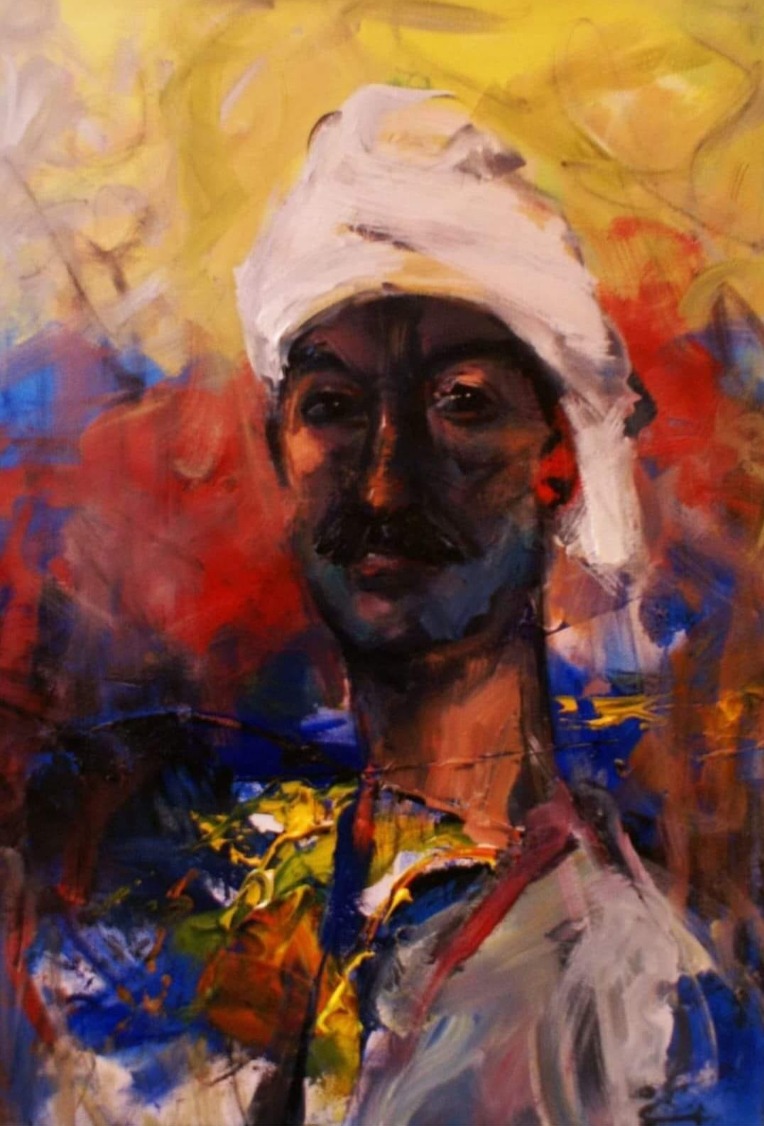 Shefqet Avdush Emini – Portreti i një Bujari nga Egjipti: Një Hyrje në Thellësinë Emocionale dhe Kulturore të Një Vepre të Lindur në Kajro
Shefqet Avdush Emini – Portreti i një Bujari nga Egjipti: Një Hyrje në Thellësinë Emocionale dhe Kulturore të Një Vepre të Lindur në Kajro
Në këtë pikturë të jashtëzakonshme të realizuar në Kajro, artisti i njohur ndërkombëtar Shefqet Avdush Emini sjell në jetë portretin e një burri egjiptian, të cilin ai e ka ndjerë si simbol të krenarisë, thjeshtësisë dhe dinjitetit të rrënjosur thellë në zemrën e kulturës arabe. Emini, i njohur për stilin e tij ekspresiv dhe për qasjen emocionale ndaj subjektit, nuk pikturon vetëm pamjen e jashtme të njeriut, por zbulon përmes brushës shpirtin e tij të brendshëm, dinjitetin e heshtur dhe peshën e historisë që mbart në vështrimin e tij.
1. Subjekti: Burrëria dhe Dinjiteti i Lindjes së Vjetër
Figura që paraqitet në këtë vepër është ajo e një burri tradicional egjiptian, i veshur me rrobat karakteristike dhe mbuluar me një shall të bardhë mbi kokë. Ai nuk është një figurë anonime, por mishërimi i një arketipi që flet për breza të tërë burrash që kanë jetuar me nder, krenari dhe lidhje të thellë me tokën dhe historinë e tyre. Vështrimi i tij i drejtpërdrejtë, por i heshtur, të fton në një dialog të brendshëm. Sytë e tij, të nxirë nga hijet dhe drita, nuk shprehin frikë apo arrogancë, por qetësi dhe prani.
Emini nuk zgjedh një model të idealizuar. Ai e përfaqëson këtë burrë me një sinqeritet të çiltër, pa retushime estetike, duke e lënë pamjen e tij të jetë vetvetja – një shprehje e autenticitetit njerëzor. Veshja tradicionale bëhet pjesë e identitetit të figurës, ndërsa shalli i bardhë është si një kurorë e pa zhurmë mbi kokën e një njeriu të thjeshtë, por fisnik.
2. Paleta e Ngjyrave: Një Fushë e Emocioneve dhe Histori Kulturore
Ngjyrat në këtë vepër nuk janë të rastësishme. Ato janë të ndërtuara si për të treguar një histori përtej figurës së paraqitur. Pjesa e sipërme e pikturës, ku dominon një e verdhë e nxehtë, ndoshta përfaqëson dritën e fuqishme të diellit egjiptian, që ndriçon dhe gërryen gjithçka njëkohësisht. Ajo dritë zbret mbi figurën e burrit dhe krijon kontrast të fortë me hijet që e përshkojnë fytyrën e tij. Kjo ndarje e dritës dhe errësirës, tipike për stilin e Eminit, nuk është vetëm një zgjidhje formale – është një metaforë për dualitetin e ekzistencës: drita dhe hije, jeta dhe vuajtja, e kaluara dhe e tashmja.
Rreth trupit të figurës shpërthejnë nuanca të kuqe, blu, portokalli dhe vjollcë, të përziera me energji të papërmbajtur. Ato krijojnë një atmosferë të turbullt, një sfond që gërsheton emocionet dhe kujtesën kolektive të një kulture të lashtë dhe të ndërlikuar si ajo egjiptiane. Këto ngjyra duket sikur lëvizin, sikur pulsojnë me jetën e vet, duke sugjeruar se ky burrë nuk është i ndarë nga mjedisi i tij, por është njësh me të. Ai është pjellë e vendit të vet – e tokës, e historisë, e popullit.
3. Struktura Kompozicionale dhe Ndikimi Ekspresivist
Në këtë pikturë, artisti nuk ndjek rregullat klasike të portretit. Ai vendos figurën në qendër, por në vend që ta vendosë në një sfond neutral, ai e zhyt në një kaos të kontrolluar ngjyrash, ku gjithçka është në lëvizje. Linjat janë të lira, konturet janë të hapura dhe gjithçka duket e ndërprerë dhe e rindërtuar me ndjeshmëri spontane. Kjo është në përputhje të plotë me filozofinë ekspresioniste të Eminit, i cili e sheh artin jo si përshkrim të realitetit, por si përshfaqje të energjisë shpirtërore.
Fytyra e burrit nuk është e detajuar me rigorozitet, por me ndjenjë. Është një fytyrë që nuk ka nevojë për hollësi për të shprehur veten – mjafton ndriçimi, tensioni në ngjyra dhe mënyra se si hijezat lëvizin mbi fytyrë për të kuptuar botën që ai përfaqëson. Figura është njëkohësisht reale dhe simbolike: reale, sepse ngjan me një njeri të vërtetë; simbolike, sepse përfaqëson një botë të tërë.
4. Konteksti dhe Inspirimi: Egjipti si Muzë
Piktura është realizuar gjatë qëndrimit të Shefqet Avdush Eminit në Kajro, një vend me një trashëgimi të jashtëzakonshme kulturore dhe historike. Egjipti, me monumentalitetin e vet, me kontrastet e thella midis lashtësisë dhe bashkëkohësisë, është një burim i pafund frymëzimi për çdo artist me ndjeshmëri të thellë. Emini, me rrënjët e tij të lidhura me tokën, kulturën dhe shpirtin e popujve, e përjeton këtë ambient jo si vizitor, por si dëgjues i brendshëm i një historie që flet përmes syve të njerëzve të thjeshtë.
Bujari që e ka frymëzuar këtë portret nuk është i famshëm. Ai nuk ka statuja në sheshe apo emra në librat e historisë. Por për artistin, ai është hero i përditshmërisë, simbol i një qëndrueshmërie morale që nuk e sheh nevojën për fjalë të mëdha. Dhe është pikërisht kjo që e ka bërë Eminin të zgjedhë ta përjetësojë me brushë.
5. Mesazhi: Njeriu si Monument i Gjallë i Kulturës
Në këtë vepër, Shefqet Avdush Emini nuk flet vetëm për një burrë të veçantë nga Egjipti. Ai flet për çdo njeri që është bartës i kulturës, i historisë dhe i shpirtit të popullit të vet. Përmes kësaj pikture, ai ngre një monument të gjallë, një portret që qëndron për të gjithë ata që jetojnë me ndershmëri, që përballen me jetën me dinjitet dhe që, megjithëse shpesh të harruar, janë themelet e shoqërisë.
Një Vepër që Bashkon Popujt përmes Shpirtit Njerëzor
Kjo pikturë është më shumë sesa një portret. Është një urë kulturore mes Ballkanit dhe Egjiptit, mes artit modern dhe figurës tradicionale, mes shpërthimit emocional dhe qetësisë së dinjitetit. Në duart e Shefqet Avdush Eminit, çdo vepër bëhet një dëshmi e asaj që nuk mund të thuhet me fjalë, por që mund të ndjehet thellë, në heshtje.Lees meer >> | 57 keer bekeken
-
Shefqet Avdush Emini: An Artist of Conscience Through Painting and Sculpture – An In-depth Analysis
13 augustus 2025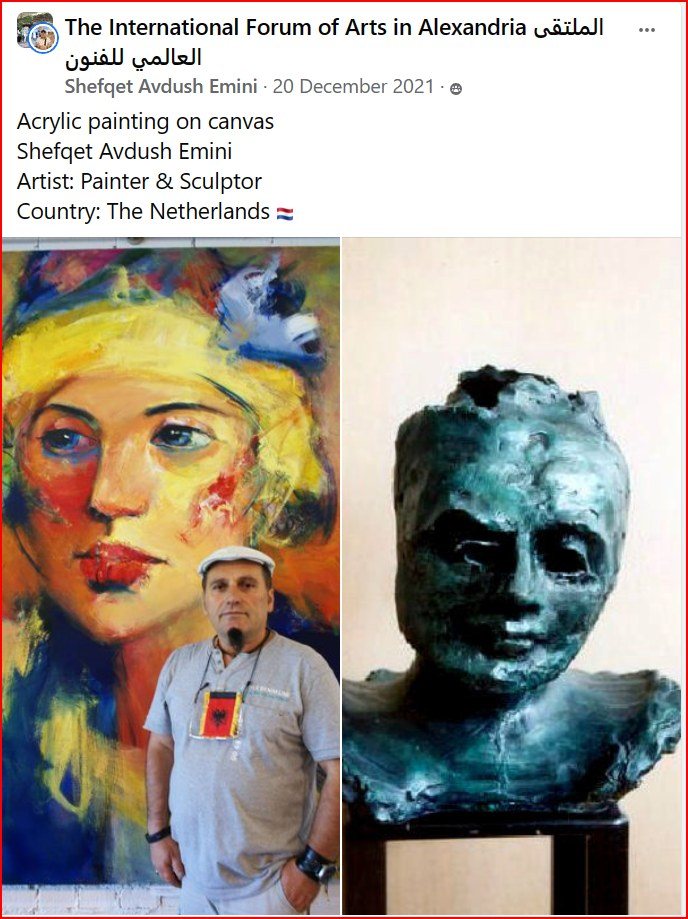 ENGLISH TRANSLATION — Shefqet Avdush Emini: An Artist of Conscience Through Painting and Sculpture – An In-depth Analysis
ENGLISH TRANSLATION — Shefqet Avdush Emini: An Artist of Conscience Through Painting and Sculpture – An In-depth Analysis
In this significant image, published within the context of Shefqet Avdush Emini’s participation in The International Forum of Arts in Alexandria, we witness a pivotal moment in his creative journey. He stands between two distinct expressions of art — painting and sculpture — two mediums which, in his hands, are not separate but interwoven through the same creative philosophy, the same sensitivity toward the human soul, pain, and the meaning of existence.
1. Painting: Emotion Unveiled on the Surface
On the left side of the image, we see a female portrait painted in acrylic on canvas, where colors erupt like an inner fire, creating a delicate tension between beauty and melancholy. The woman's face, with eyes gazing far beyond, filled with a silence heavy with sensitivity, represents more than just a face — it is a symbol.
The use of color in this painting is essential. Emini does not use colors as decorative surfaces, but as pure emotional energy. Flaming yellows and oranges clash with dark blues and shades of red, creating an explosive yet controlled atmosphere — a soul in a constant effort to communicate with the world. Her silent gaze seems to gain the voice that reality has denied her — a muted scream, a memory too heavy to articulate in words. The structure of the face is not academic but shaped through feeling, where every brushstroke is an internal word from the artist.
This painting clearly reflects the influence of abstract expressionism, but also elements of visual psychology. It is not a conventional portrait, but an attempt to capture the emotional essence of the figure. It is the face of a woman who represents all women: the mother, the sister, the lover, the victim of war, the hope, the patience, and the sorrow of humanity.
2. Sculpture: Memory Imprinted in Matter
On the right side of the image stands a bronze sculpture — a bust with an archaic, pained, and mysterious expression. The cold, deep tone of the bronze lends the piece a timeless quality, as if it were an artifact unearthed from a forgotten city of human history. But what makes this sculpture extraordinary is the language it uses to communicate beyond form: the language of eternal silence.
The face is incomplete, like a memory that has begun to fade but refuses to be erased entirely. This lack of detail is not a flaw, but an artistic necessity. With rare mastery, Emini allows the material to speak for itself: the cracks, imperfections, and uneven surface textures are precisely what give the piece its emotional and human authenticity.
At its core, this sculpture is a monument to the unknown human — to the victim, the witness, the one who passed through the infernos of history and remains silent. It is a representation of silent suffering, but also of endurance. It is nameless because it represents everyone. And this universality gives the work both moral strength and ethical dimension.
3. Shefqet Avdush Emini: Between Two Worlds, a Singular Spirit
Placing these two works side by side — the painting and the sculpture — is to understand the depth and breadth of Shefqet Avdush Emini's creative spirit. He is not limited by material. He is not bound by visual language. He is a conduit for human experience, regardless of the form it takes.
His painting represents the eruption of emotions, the inner voice, the poetic rebellion against injustice and pain. His sculpture is the quiet remembrance, the call for reflection, the heavy structure of memory embedded in matter. In both mediums, he seeks the same thing: truth.
Shefqet Emini is not merely an artist, but a creative conscience striving to grasp the ungraspable. He does not see art as decoration or ornament, but as an ethical act — a response to the world, a spiritual document of existence. His entire body of work is infused with profound symbolism, where every form is an unspoken word, every color a thought, and every empty space a silence that speaks.
4. International Context and Universal Meaning
The fact that this photo was published at the International Forum of Arts in Alexandria — a culturally significant event in the Arab world and beyond — demonstrates the high level of international recognition Emini has attained. He represents not only the Netherlands, but also his Albanian roots and the universal spirit of art that transcends national borders.
His art is a bridge between East and West, between tradition and contemporaneity, between the figurative and the abstract. In his work we find traces of Balkan heritage, but transformed into a language that speaks to everyone.
In this single photograph, Shefqet Avdush Emini stands between two works that represent two poles of his artistry — the emotional outburst and the memorial of remembrance. It is a testimony to his artistic richness, his human sensitivity, and his dedication to an art that not only expresses, but also affects, heals, protests, and remembers.
In a world where forgetfulness often triumphs over memory, and emptiness over substance, the works of Shefqet Avdush Emini stand as monuments of conscience and as a call to never forget that art is, above all, a profound form of love for life and for humanity.Shefqet Avdush Emini – Një Artist i Ndërgjegjes përmes Pikturës dhe Skulpturës: Një Analizë e Thelluar
Në këtë imazh domethënës, i publikuar në kuadër të pjesëmarrjes së artistit Shefqet Avdush Emini në The International Forum of Arts in Alexandria, shfaqet një moment thelbësor i veprës së tij krijuese. Ai qëndron mes dy shprehjeve të ndryshme të artit – pikturës dhe skulpturës – dy gjini që në duart e tij nuk janë të ndara, por të ndërthurura nga e njëjta filozofi krijuese, e njëjta ndjeshmëri ndaj shpirtit njerëzor, dhimbjes dhe kuptimit të ekzistencës.
1. Piktura: Shpërfaqja e Ndjenjës në Sipërfaqe
Në anën e majtë të imazhit, shihet një portret femëror i pikturuar me teknikë akriliku mbi kanavacë, ku ngjyrat shpërthejnë si zjarr i përbrendshëm, duke krijuar një tension të brishtë mes bukurisë dhe melankolisë. Fytyra e gruas, me sytë që shikojnë tej, e mbushur me një heshtje të ngarkuar me ndjeshmëri, përfaqëson më shumë sesa një fytyrë – ajo është një simbol.
Përdorimi i ngjyrës në këtë pikturë është thelbësor. Emini nuk i përdor ngjyrat si sipërfaqe zbukuruese, por si energji të pastër emocionale. Të verdhat dhe portokallet flakëruese përplasen me blutë e errëta dhe nuancat e kuqe, duke krijuar një atmosferë shpërthyese, por të kontrolluar, të një shpirti në përpjekje për të komunikuar me botën. Vështrimi i heshtur i gruas duket sikur përfton zërin që mungon në realitet, një klithmë e ndaluar, një kujtim që nuk shprehet dot me fjalë. Struktura e fytyrës nuk është akademike, por e ndërtuar përmes ndjesisë, ku çdo brushë është një fjalë e brendshme e artistit.
Në këtë pikturë, mund të shohim qartë ndikimin e ekspresionizmit abstrakt, por gjithashtu edhe elementë të psikologjisë vizuale. Nuk kemi të bëjmë me një portret të zakonshëm, por me një përpjekje për të kapur esencën emocionale të figurës. Është fytyra e një gruaje që përfaqëson gjithë gratë: nënën, motrën, të dashurën, viktimën e luftës, shpresën, durimin dhe pikëllimin e njerëzimit.
2. Skulptura: Kujtimi i Shenjuar në Materie
Lees meer >> | 58 keer bekeken
-
Përshkrim dhe Analizë e Thelluar e Një Vepre nga Shefqet Avdush Emini
13 augustus 2025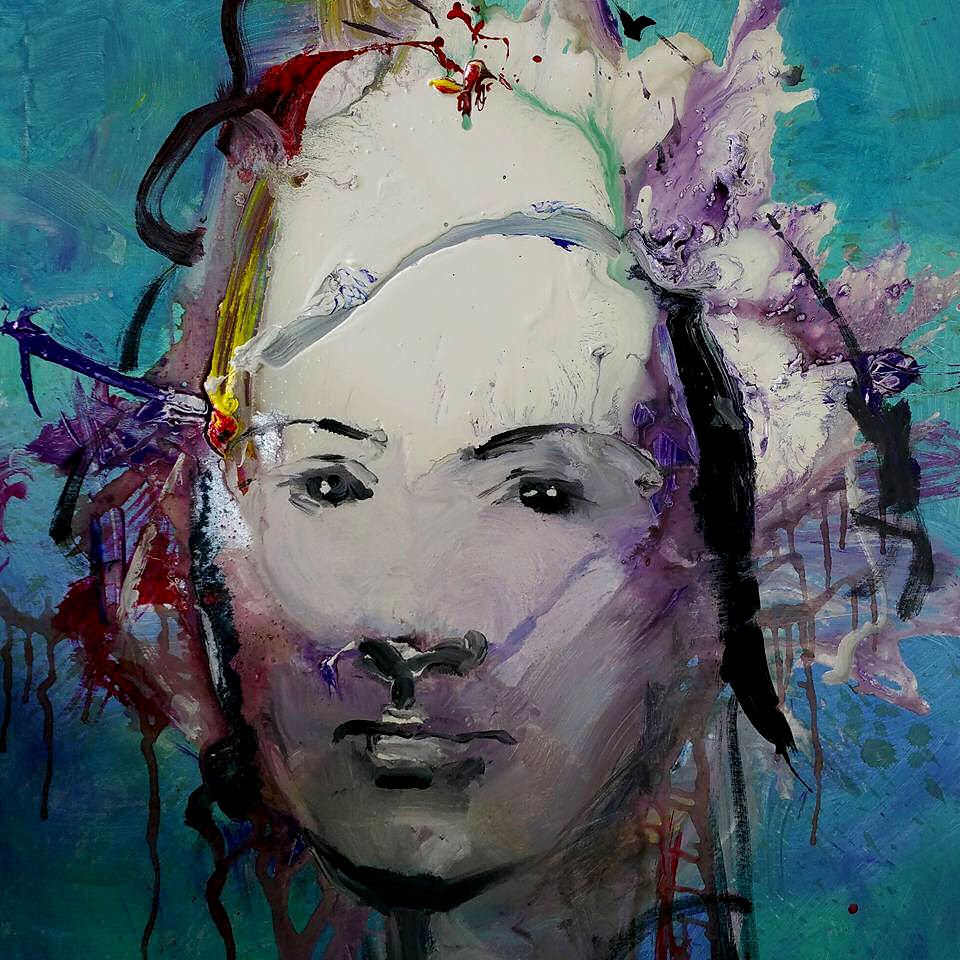
Përshkrim dhe Analizë e Thelluar e Një Vepre nga Shefqet Avdush Emini
Kjo pikturë e realizuar nga mjeshtri i ekspresionizmit abstrakt, Shefqet Avdush Emini, qëndron si një manifest emocional dhe estetik i shpirtit njerëzor të trazuar, një gjurmë vizuale e realiteteve të përjetuara e të nënndërgjegjshme, që kapërcejnë kufijtë e kohës dhe vendit. Si në shumicën e krijimtarisë së tij, edhe në këtë kompozim, Emini nuk kërkon të riprodhojë botën e jashtme, por e zhbiron atë që ndodh në thellësitë e brendshme të qenies. Ai nuk merret me përshkrimin, por me ndjesimin. Nuk e shtjellon subjektin, por e tejçon në një mënyrë që ndikon drejtpërdrejt në psiken e shikuesit.
Në pamje të parë, struktura kompozicionale e pikturës duket e fragmentuar, e përbërë nga forma të shpërthyera dhe linja që ndërpriten, bashkohen, e më pas zhduken. Ngjyrat nuk janë të lehta për syrin, por të thella, dramatike, të plota me një tension të brendshëm. Kjo mënyrë përzgjedhjeje ngjyrash – shpesh të përplasura mes vete – krijon një atmosferë që mund të interpretohet si përplasje e mendimeve, emocioneve, fateve dhe rrugëve të ndrydhura të ekzistencës njerëzore. Ngjyrat nuk janë këtu për të dekoruar, por për të thënë një të vërtetë të thellë. Ato janë britma, janë heshtje të zgjatura, janë gërvishtje mbi sipërfaqen e kujtesës kolektive.
Figura njerëzore në këtë vepër nuk shfaqet në mënyrë tradicionale. Ajo është e shpërbërë, e transformuar, e tejkaluar. Koka mund të jetë vetëm një formë e errët, një hije, një siluetë e cunguar që i ngjan më shumë një kujtese të largët sesa një portreti të gjallë. Trupi, nëse është i pranishëm, është më tepër metaforë sesa përfaqësim. Kjo "shpërfytyrim" nuk është thjesht një zgjedhje estetike, por një deklaratë filozofike: njeriu në veprat e Eminit është viktimë e kohërave, e luftërave, e shpërnguljeve, e harrimit. Ai nuk është hero, por dëshmitar i një historie që ka shpesh fytyrën e dhimbjes.
Në këtë vepër, piktori nuk i jep shikuesit një udhërrëfyes narrativ. Nuk ka një “subjekt” në kuptimin klasik – nuk ka një histori me fillim e fund. Në vend të kësaj, kemi një përjetim të hapur, një ftesë për të hyrë në një hapësirë të fragmentuar psikologjike, ku çdo njollë ngjyre është një impuls, një vrull, një plagë e hapur. Gjuha e tij vizuale është një lloj arkeologjie e shpirtit, ku shtresat e pikturës zbulohen si shtresa kujtese dhe përvoje.
Një element tjetër i rëndësishëm në këtë pikturë është tekstura. Përdorimi i furçës nuk është i butë, por brutal, ekspresiv, i mbushur me tension. Duket sikur autori nuk ka pikturuar, por ka luftuar me kanavacën, si një akt i domosdoshëm për të nxjerrë jashtë brendësinë e vet. Kanavaca është bërë një fushë beteje e emocioneve – një vend ku instinktet, kujtimet dhe vizionet përplasen.
Veprat e Shefqet Avdush Eminit nuk mund të lexohen në mënyrë sipërfaqësore. Ato kërkojnë një përkushtim emocional dhe intelektual nga shikuesi. Kërkojnë që të mos jesh thjesht spektator, por pjesëmarrës. Ky artist nuk pikturon për të argëtuar, por për të bërë pyetje. Dhe pyetjet që ngrihen nga kjo vepër janë të forta: Çfarë do të thotë të jesh njeri pas një traume kolektive? Si ruhet humaniteti në kohë të errëta? Si ndërtohet kujtesa në një botë që përpiqet ta fshijë atë?
Nëse do ta vendosnim këtë pikturë në një kontekst më të gjerë të artit bashkëkohor, ajo do të qëndronte pranë atyre veprave që nuk pranojnë të jenë të heshtura përballë tragjedive të njerëzimit. Ajo përkujton, proteston, sfidon. Ka një dimension etik të fortë në këtë vepër, ku piktori nuk është vetëm krijues, por dëshmitar dhe ndërmjetës mes kujtesës dhe harresës.
Në përfundim, kjo pikturë e Shefqet Avdush Eminit është një veprim estetik dhe moral njëkohësisht. Ajo nuk është një imazh, por një përjetim. Nuk është një dekor, por një thirrje për ndërgjegjësim. Është një krismë që vjen nga thellësitë e shpirtit njerëzor dhe përplaset në murin e indiferencës shoqërore. Dhe kjo e bën atë jo vetëm një vepër arti, por një dëshmi e pavdekshme për kohët që kemi kaluar, që po jetojmë dhe që duhet t’i shërojmë.
ENGLISH TRANSLATION — Description and In-Depth Analysis of a Work by Shefqet Avdush Emini
This painting, created by the master of abstract expressionism Shefqet Avdush Emini, stands as an emotional and aesthetic manifesto of the troubled human spirit—a visual trace of experienced and subconscious realities that transcend the boundaries of time and place. As in much of his oeuvre, in this composition as well, Emini does not seek to reproduce the external world but rather penetrates what unfolds in the inner depths of being. He does not concern himself with description but with sensation. He does not narrate the subject; he transmits it in a way that impacts the viewer’s psyche directly.
At first glance, the compositional structure of the painting appears fragmented—comprised of explosive forms and lines that interrupt, merge, and then disappear. The colors are not easy on the eye but deep, dramatic, filled with internal tension. This method of color selection—often clashing—creates an atmosphere that can be interpreted as a collision of thoughts, emotions, destinies, and suppressed paths of human existence. These colors are not here to decorate but to speak a deeper truth. They are screams, prolonged silences, scratches upon the surface of collective memory.
The human figure in this work does not appear in a traditional way. It is dissolved, transformed, transcended. The head may be only a dark shape, a shadow, a truncated silhouette resembling more a distant memory than a living portrait. The body, if present, is more metaphor than representation. This "distortion" is not merely an aesthetic choice but a philosophical declaration: the human in Emini’s works is a victim of times, wars, displacements, and forgetfulness. He is not a hero but a witness to a history that often wears the face of pain.
In this work, the artist provides no narrative guide to the viewer. There is no "subject" in the classical sense—no story with a beginning and end. Instead, we are offered an open experience, an invitation into a fragmented psychological space where every patch of color is an impulse, a surge, an open wound. His visual language is a kind of archaeology of the soul, where the layers of paint reveal layers of memory and experience.
Another crucial element in this painting is texture. The brushwork is not gentle but brutal, expressive, filled with tension. It seems as though the artist hasn’t painted but wrestled with the canvas—as an essential act to externalize his inner world. The canvas becomes a battlefield of emotions—a place where instincts, memories, and visions collide.
Shefqet Avdush Emini’s works cannot be read superficially. They demand emotional and intellectual engagement from the viewer. They require one not to be merely a spectator, but a participant. This artist does not paint to entertain but to raise questions. And the questions raised by this work are profound: What does it mean to be human after collective trauma? How is humanity preserved in dark times? How is memory built in a world that seeks to erase it?
Placed within a broader context of contemporary art, this painting would stand alongside those works that refuse to remain silent in the face of human tragedy. It remembers, it protests, it challenges. There is a strong ethical dimension to this work, where the painter is not only a creator but also a witness and mediator between memory and forgetting.
In conclusion, this painting by Shefqet Avdush Emini is both an aesthetic and moral act. It is not an image, but an experience. It is not a decoration, but a call to awareness. It is a cry from the depths of the human soul, clashing against the wall of social indifference. And that makes it not only a work of art, but an immortal testimony to the times we have lived through, are living in, and must heal from.Lees meer >> | 54 keer bekeken
-
Nga Faruk Tasholli: Intervistë me piktorin Shefqet Avdush emini
13 augustus 2025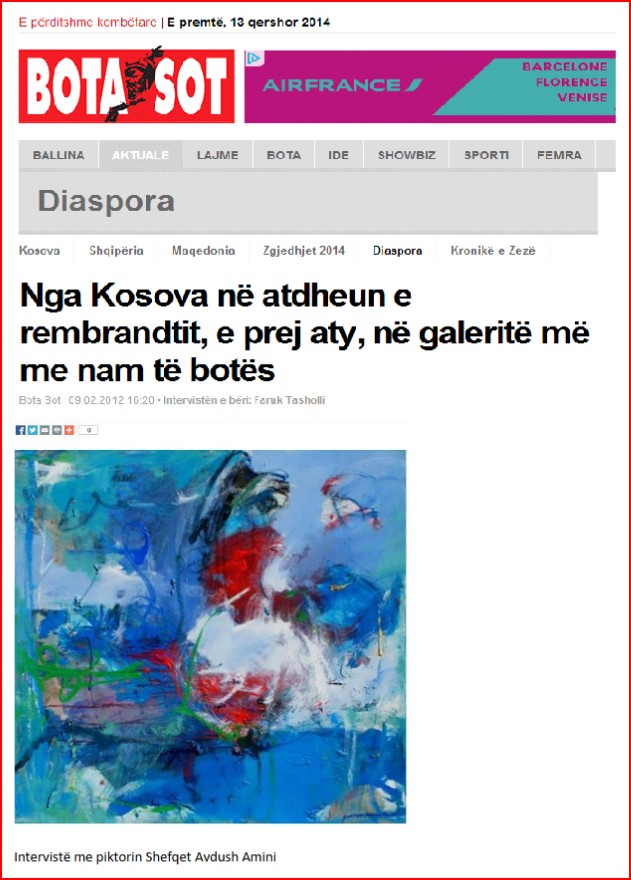 Nga Kosova në atdheun e Rembrandtit, e prej aty, në galeritë më me nam të botës
Nga Kosova në atdheun e Rembrandtit, e prej aty, në galeritë më me nam të botës
Intervistë e bërë: Faruk Tasholli
Intervistë me piktorin Shefqet Avdush Emini
Atelietë e Akademisë së Arteve të Universitetit të Prishtinës në ato ndërtesa përcjellëse që ruanin vjetërsinë e kryeqytetit hapësirave universitare ku po lëshonin shtat Biblioteka, ngadoqë për sigurti po i kultivonin artistët e ri, na fusnin në pikturë, të grafikës, të skulpturës, ndoshta në një tjetër kujnonin zërat base, tenore, baritone e soprane; përhapin instrumente e zëra muzikorë. Nga ato atelie, me homazh për muzat përjetë e vizatime që mëngjeseve herët e mbanin nën ngazëll, hynte e dilte studenti i pikturës Shefqet Avdush Emini, nga një nxënës i mirë në klasën e Profesor Nysret Salihamixhiqi, për t’i bërë shumë më vite më vonë, me pikturat e tij, pjesë e galerive dhe muzeve më me renome të metropoleve artistike botërore. I lindur në fshatin me histori të Kosovës, piktori Pejzazheve në fushës dhe maleve të Sharrit përballet Shefqet Avdush Emini, në fëmijëri, nuk do të ketë mundësi të pikturojë me mjete të ndryshme, por vetëm me ato që i ofronte natyra e atdheut të varfër.
Ai pas gjimnazit në Shtime dhe në Ferizaj, bëhet student i Akademisë së Arteve në Prishtinë, ku pjesën më të madhe të kohës e kalon me atelie duke pikturuar dhe duke studiuar vepra të mjeshtërive të mëdhenj. Si autodidakt, do ta ketë Rembrandtin, ku në një ditë, përputrë do të jetë pjesë e atdheut të tij. Duke në filmat të viteve të rinisë studentore, pas pirjes së një pije në kafet pranë Akademisë me profesor Anton Gllasalinin, aty hyn Shefqeti. Ulun me të, profesori, profesor student i tij mezi gjente ku t’ua vendoste bllokun në mjedh. Fjalët e Antonit i kuptova si kurajo për studentin e tij, ndoshta me lot, e ashtu shkruan në kujtimet e tij.
Pas Akademisë dhe pas punës në Kosovë, ai do të gjejë vendin ku vazhdon jetën – në Holandë, pasuar shpejt edhe bashkëshortja e tij. Ai do të punojë në këtë vend, i rrethuar nga familja e tij dhe nga vlera e artit të tij në galeri e muze të mëdhenj. Arti dhe artisti Shefqet Avdush Emini, bëjnë të ndalet ora për pak çaste për ta dëgjuar intervistën për lexuesit shqiptarë.Lees meer >> | 77 keer bekeken
-
Nga Kosova në atdheun e Rembrandtit, e prej aty, në galeritë më me nam të botës Intervistë e bërë: Faruk Tasholli
13 augustus 2025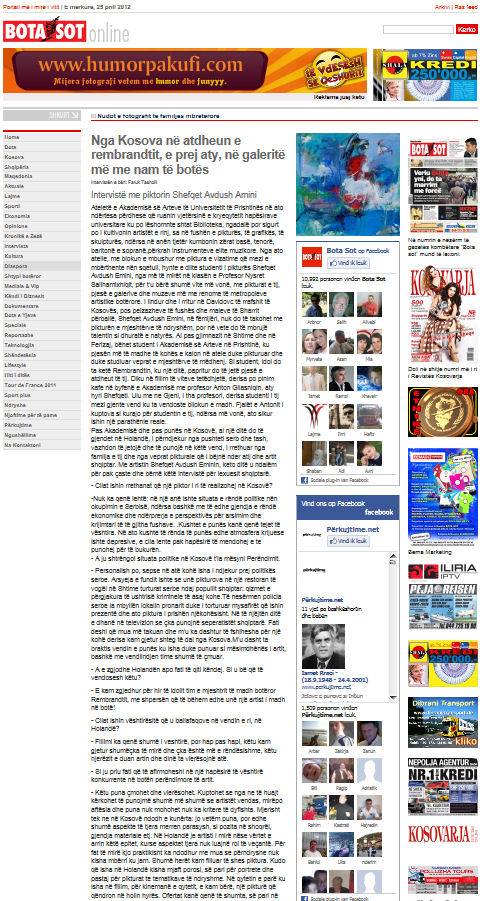 Nga Kosova në atdheun e Rembrandtit, e prej aty, në galeritë më me nam të botës
Nga Kosova në atdheun e Rembrandtit, e prej aty, në galeritë më me nam të botës
Intervistë e bërë: Faruk Tasholli
Intervistë me piktorin Shefqet Avdush Emini
Atelietë e Akademisë së Arteve të Universitetit të Prishtinës në ato ndërtesa përcjellëse që ruanin vjetërsinë e kryeqytetit hapësirave universitare ku po lëshonin shtat Biblioteka, ngadoqë për sigurti po i kultivonin artistët e ri, na fusnin në pikturë, të grafikës, të skulpturës, ndoshta në një tjetër kujnonin zërat base, tenore, baritone e soprane; përhapin instrumente e zëra muzikorë. Nga ato atelie, me homazh për muzat përjetë e vizatime që mëngjeseve herët e mbanin nën ngazëll, hynte e dilte studenti i pikturës Shefqet Avdush Emini, nga një nxënës i mirë në klasën e Profesor Nysret Salihamixhiqi, për t’i bërë shumë më vite më vonë, me pikturat e tij, pjesë e galerive dhe muzeve më me renome të metropoleve artistike botërore. I lindur në fshatin Davidovc me histori të Kosovës, piktori Pejzazheve në fushës dhe maleve të Sharrit përballet Shefqet Avdush Emini, në fëmijëri, nuk do të ketë mundësi të pikturojë me mjete të ndryshme, por vetëm me ato që i ofronte natyra e atdheut të varfër.
Ai pas gjimnazit në Shtime dhe në Ferizaj, bëhet student i Akademisë së Arteve në Prishtinë, ku pjesën më të madhe të kohës e kalon me atelie duke pikturuar dhe duke studiuar vepra të mjeshtërive të mëdhenj. Si autodidakt, do ta ketë Rembrandtin, ku në një ditë, përputrë do të jetë pjesë e atdheut të tij. Duke në filmat të viteve të rinisë studentore, pas pirjes së një pije në kafet pranë Akademisë me profesor Anton Gllasalinin, aty hyn Shefqeti. Ulun me të, profesori, profesor student i tij mezi gjente ku t’ua vendoste bllokun në mjedh. Fjalët e Antonit i kuptova si kurajo për studentin e tij, ndoshta me lot, e ashtu shkruan në kujtimet e tij.
Pas Akademisë dhe pas punës në Kosovë, ai do të gjejë vendin ku vazhdon jetën – në Holandë, pasuar shpejt edhe bashkëshortja e tij. Ai do të punojë në këtë vend, i rrethuar nga familja e tij dhe nga vlera e artit të tij në galeri e muze të mëdhenj. Arti dhe artisti Shefqet Avdush Emini, bëjnë të ndalet ora për pak çaste për ta dëgjuar intervistën për lexuesit shqiptarë.
From Kosovo to the homeland of Rembrandt, and from there, to the world’s most renowned galleries
Interview by: Faruk Tasholli
Interview with the painter Shefqet Avdush Emini
The studios of the Academy of Arts at the University of Pristina, in those adjoining buildings that preserved the old spirit of the capital in their academic spaces—where the Library stood tall—were surely nurturing young artists. They welcomed us into painting, graphics, sculpture; perhaps another studio echoed with the voices of basses, tenors, baritones, and sopranos; or spread the sounds of musical instruments and voices. From those studios, with homage to the muses, and with drawings that filled early mornings with delight, came and went the painting student Shefqet Avdush Emini, once an excellent pupil in Professor Nysret Salihamixhiqi’s class, who many years later, with his paintings, would become part of the galleries and museums with the greatest renown in the world’s artistic metropolises.
Born in a village Davidov rich with Kosovo’s history, the painter of the landscapes of the fields and mountains of Sharr, Shefqet Avdush Emini, in his childhood did not have the opportunity to paint with a variety of materials—only with what nature offered in his poor homeland.
After finishing high school in Shtime and Ferizaj, he became a student at the Academy of Arts in Pristina, where he spent most of his time in the studios painting and studying the works of great masters. As an autodidact, he would take Rembrandt as his model, and one day, fate would lead him to the painter’s homeland. In the films of his student years, after having a drink in the cafés near the Academy with Professor Anton Gllasalini, Shefqet entered the scene. Sitting with him, the professor—once his own professor and student—hardly found a place to set down his sketchbook. I understood Anton’s words as encouragement for his student, perhaps even with tears, and thus he wrote them in his memories.
After the Academy and after working in Kosovo, he would find the country where he would continue his life—The Netherlands—soon joined by his wife. There he would work, surrounded by his family and the value of his art in major galleries and museums. The art and artist Shefqet Avdush Emini make time stop for a few moments to hear this interview for the Albanian readers.Lees meer >> | 59 keer bekeken
-
Pikturova këtë javë me një mik, një artist të madh nga Holanda
13 augustus 2025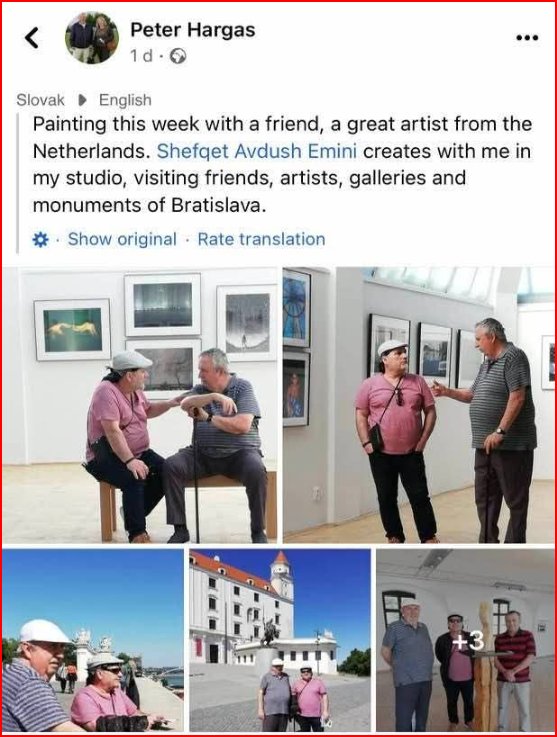
Pikturova këtë javë me një mik, një artist të madh nga Holanda. Shefqet Avdush Emini krijoj bashkë me mua, në studion time. Vizituam miq, artistë, galeri dhe monumente të Bratislavës.
Lees meer >> | 54 keer bekeken
-
SHEFQET ADVUSH EMINI, një artist për t’u admiruar! Një jetë e tërë e dhënë artit
13 augustus 2025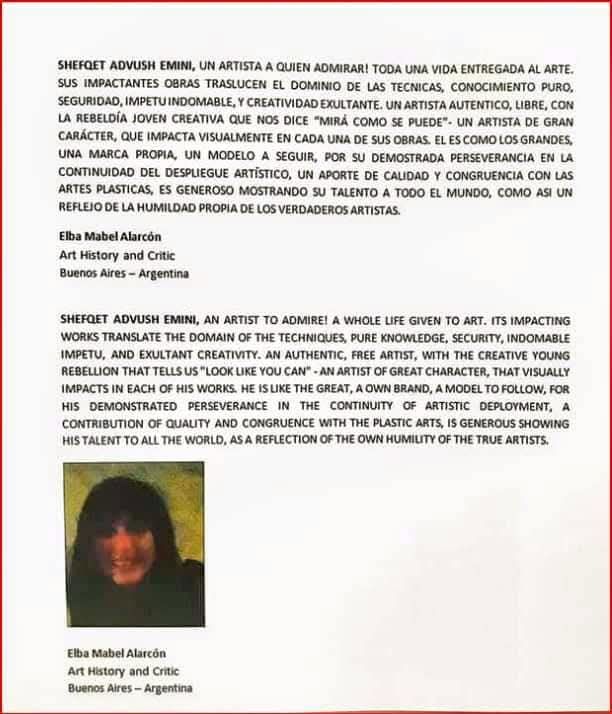 SHEFQET ADVUSH EMINI, një artist për t’u admiruar! Një jetë e tërë e dhënë artit. Veprat e tij mbresëlënëse tregojnë zotërimin e teknikave, njohuri të pastra, siguri, vrull të pathyeshëm dhe krijimtari të shkëlqyer. Një artist autentik, i lirë, me rebelimin e ri krijues që na thotë “Shiko si mund të bëhet”. Një artist me karakter të madh, që të godet vizualisht në secilën prej veprave të tij. Ai është si të mëdhenjtë, një markë më vete, një model për t’u ndjekur, për këmbënguljen e tij të dëshmuar në vazhdimësinë e shpalosjes artistike, një kontribut cilësor dhe në përputhje me artet pamore, është bujar duke e treguar talentin e tij para gjithë botës, ashtu siç është edhe pasqyrim i përulësisë së vërtetë të artistëve të mëdhenj.
SHEFQET ADVUSH EMINI, një artist për t’u admiruar! Një jetë e tërë e dhënë artit. Veprat e tij mbresëlënëse tregojnë zotërimin e teknikave, njohuri të pastra, siguri, vrull të pathyeshëm dhe krijimtari të shkëlqyer. Një artist autentik, i lirë, me rebelimin e ri krijues që na thotë “Shiko si mund të bëhet”. Një artist me karakter të madh, që të godet vizualisht në secilën prej veprave të tij. Ai është si të mëdhenjtë, një markë më vete, një model për t’u ndjekur, për këmbënguljen e tij të dëshmuar në vazhdimësinë e shpalosjes artistike, një kontribut cilësor dhe në përputhje me artet pamore, është bujar duke e treguar talentin e tij para gjithë botës, ashtu siç është edhe pasqyrim i përulësisë së vërtetë të artistëve të mëdhenj.
Elba Mabel Alarcón
Historiane dhe kritike arti
Buenos Aires – ArgjentinëLees meer >> | 53 keer bekeken
-
Unë u njoha me artistin e talentuar, të mençur, të drejtë dhe të shkëlqyeshëm, Shefqet Avdush Emini për herë të parë, në Simpoziumin Mush 2019
13 augustus 2025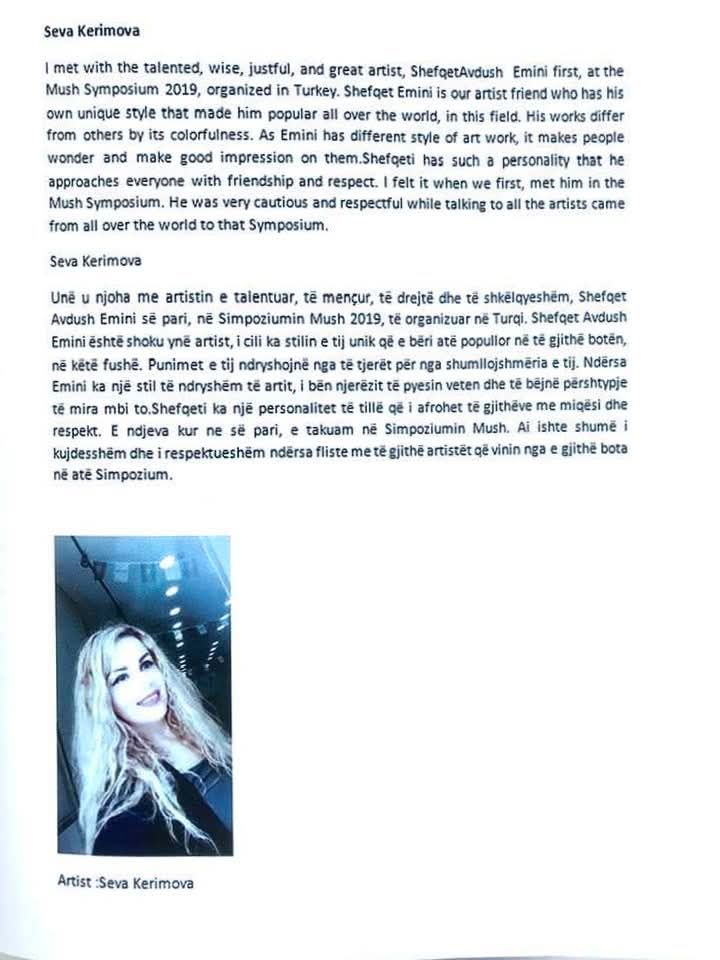
Seva Kerimova
Unë u njoha me artistin e talentuar, të mençur, të drejtë dhe të shkëlqyeshëm, Shefqet Avdush Emini për herë të parë, në Simpoziumin Mush 2019, të organizuar në Turqi. Shefqet Avdush Emini është shoku ynë artist, i cili ka stilin e tij unik që e bëri atë popullor në të gjithë botën, në këtë fushë. Punimet e tij ndryshojnë nga të tjerët për nga shumëllojshmëria e tij. Ndërsa Emini ka një stil të ndryshëm të artit, i bën njerëzit të pyesin veten dhe të bëjnë përshtypje të mira mbi to. Shefqeti ka një personalitet të tillë që i afrohet të gjithëve me miqësi dhe respekt. E ndjeva kur ne së pari, e takuam në Simpoziumin Mush. Ai ishte shumë i kujdesshëm dhe i respektueshëm ndërsa fliste me të gjithë artistët që vinin nga e gjithë bota në atë Simpozium.
Artist: Seva KerimovaLees meer >> | 49 keer bekeken
-
Grupi përfaqëson Mbretërinë në Portugali
13 augustus 2025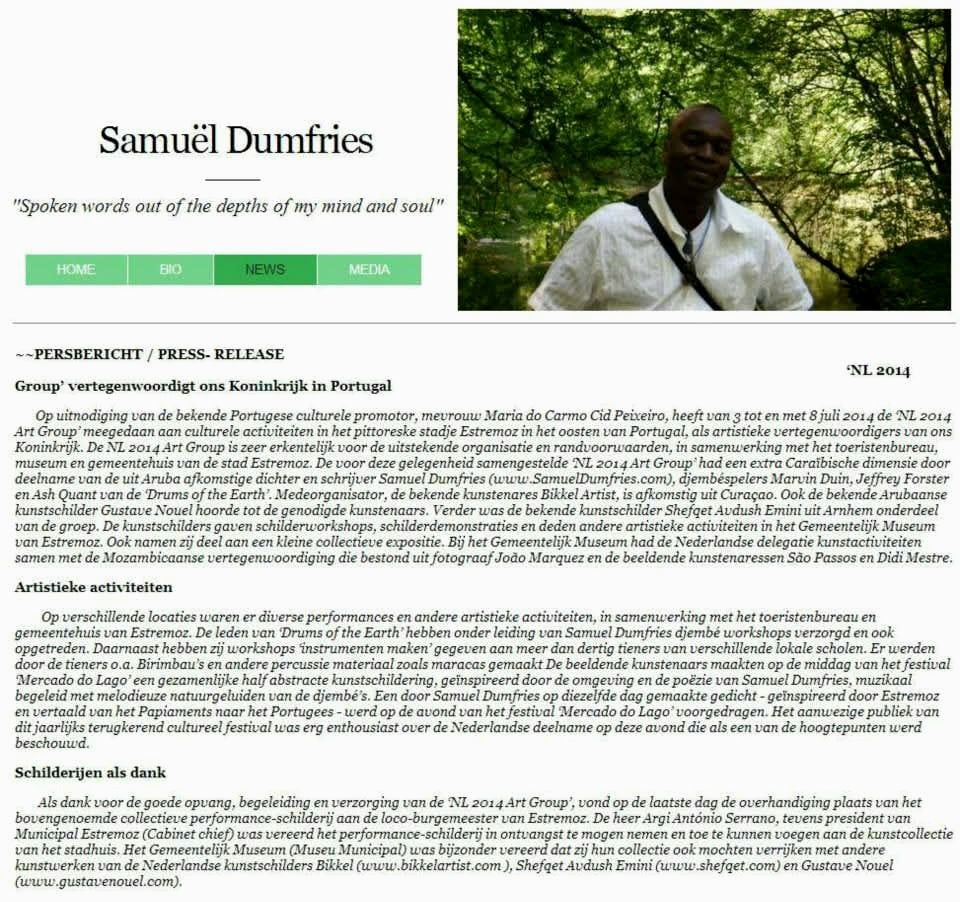 Samuel Dumfries
Samuel Dumfries
"Fjalë të folura që vijnë nga thellësitë e mendjes dhe shpirtit tim"
KOMUNIKATË PËR SHTYP
Grupi përfaqëson Mbretërinë në Portugali
Me ftesë të promovueses së njohur kulturore portugeze, zonjës Maria do Carmo Cid Peixeiro, nga data 9 deri më 8 korrik 2014, "NL 2014 Art Group" mori pjesë në aktivitete kulturore në qytetin piktoresk Estremoz në lindje të Portugalisë, si përfaqësues artistikë të Mbretërisë sonë.
"NL 2014 Art Group" është shumë mirënjohës për organizimin e shkëlqyer dhe mikpritjen, në bashkëpunim me zyrën e turizmit, muzeun dhe bashkinë e qytetit Estremoz. Për këtë rast, grupi "NL 2014 Art Group" solli një dimension të veçantë Karaibe falë pjesëmarrjes së poetit dhe shkrimtarit nga Aruba, Samuel Dumfries (www.SamuelDumfries.com), perkusionistëve Marvin Duin, Jeffrey Forster dhe Ash Quant nga “Drums of the Earth”.
Pjesëmarrës të tjerë ishin edhe artisti i njohur Bikkel Artis nga Curaçao, si dhe piktori i mirënjohur arubian Gustave Nouel, i cili iu bashkua grupit gjatë qëndrimit. Gjithashtu, artisti i njohur Shefqet Avdush Emini nga Arnhem mori pjesë në grup. Artistët mbajtën demonstrata artistike dhe morën pjesë në aktivitete të tjera artistike në Muzeun Bashkiak të Estremozit. Ata gjithashtu morën pjesë në një ekspozitë kolektive. Në këtë muze, delegacioni holandez ndau hapësirën artistike me përfaqësues të Mozambikut si fotografi João Marquez dhe artistët vizualë São Passos dhe Didi Mestre.
Aktivitete artistike
Në vende të ndryshme u zhvilluan performanca të ndryshme dhe aktivitete të tjera artistike, në bashkëpunim me zyrën e turizmit dhe bashkinë e Estremozit. Anëtarët e grupit “Drums of the Earth” shfaqën performanca që tërhoqën shumë spektatorë dhe vizitorë të shumtë.
Përveç kësaj, ata mbajtën edhe punëtori muzikore për fëmijët dhe nxënësit e shkollave vendase. Festivali përfshiu edhe pjesëmarrjen e artistëve muzikorë të njohur vendas. Me ftesë të organizatorëve, grupi performoi edhe gjatë ceremonisë përmbyllëse në kështjellën e Estremozit.
Përveç performancave, u organizuan edhe prezantime vizuale nga piktorët dhe artistët pjesëmarrës, të cilët gjithashtu zhvilluan sesione artistike në natyrë.
Pikturë si falënderim
Si shenjë falënderimi për mikpritjen e ngrohtë dhe bashkëpunimin gjatë festivalit, në ditën e fundit u bë dorëzimi i një pikture kolektive për kryetarin e bashkisë së Estremozit, Dr. Luis Mourinha. Piktura u realizua nga piktori holandez Antoon Versteegde dhe u ekspozua në Muzeun Bashkiak të Estremozit (Gabinete de Cultura).Lees meer >> | 58 keer bekeken